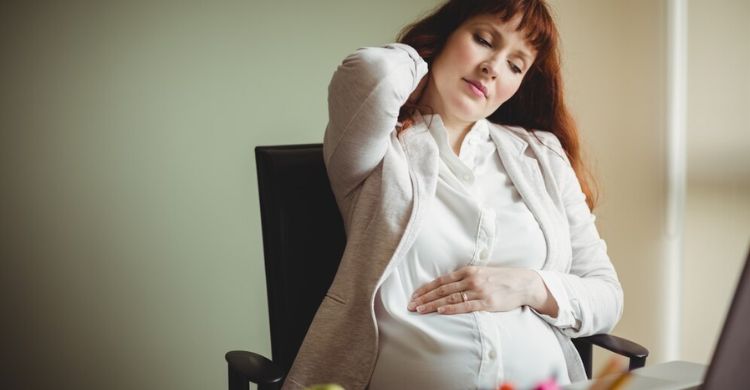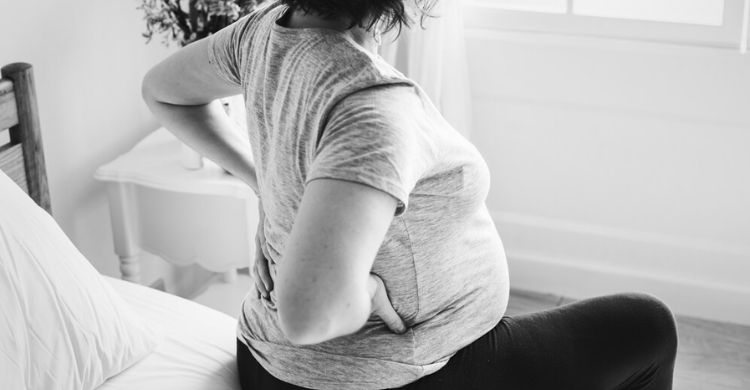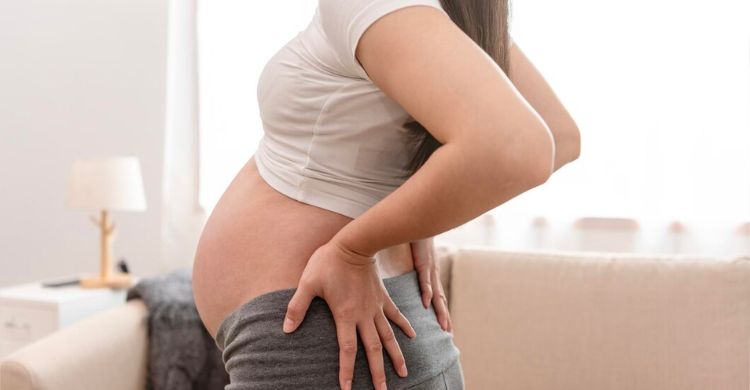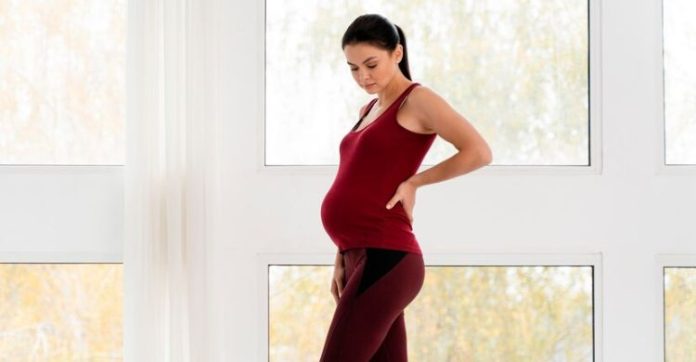Pregnancy is a beautiful journey, but it comes with its challenges. One common struggle for expecting mothers is back pain, which can range from mild discomfort to severe pain. Let’s explore what causes back pain during pregnancy, how it changes through the trimesters, and practical tips to manage it effectively.
Causes of Back Pain During Pregnancy
Backache during pregnancy typically happens where the pelvis meets your spine at the sacroiliac joint. There are several possible reasons why it happens. Below are a few of the more likely causes:
Weight Gain
During pregnancy, women generally gain between 25 and 35 pounds, and the spine has to support that weight, causing lower back pain. The growing baby’s weight and uterus also pressure the blood vessels and nerves in the pelvis and back.
Posture Changes
Pregnancy shifts your center of gravity, which results in you gradually—even without noticing—beginning to adjust your posture and movement, which results in strain or back pain.
Hormone Changes
At the time of pregnancy, your body makes a hormone called relaxin. This hormone relaxes ligaments in the pelvic area, and joints become looser in preparation for birth. However, the same hormone causes ligaments that support the spine to loosen, which leads to instability and pain.
Muscle Separation
With the expansion of the uterus, two parallel sheets of muscles (the rectus abdominis muscles) running from the rib cage to the pubic bone may separate along the center seam, worsening back pain.
Stress
Emotional stress causes muscle tension in the back. It may be felt as back pain or back spasms. You may experience increased back pain during stressful periods of your pregnancy.
Back Pain During First Trimester
During the first trimester, many women are surprised to experience low back pain in pregnancy the first trimester even though their baby bump has yet to show.

Causes of Back Ache in 1st Trimester
- Hormonal Changes: The hormone relaxin loosens ligaments and joints to prepare the body for labor, but this can also destabilize the backbone and lead to an aching back during pregnancy.
- Postural Adjustments: As your body begins to adapt to pregnancy, even minor shifts in posture can cause strain, leading to pain in the back during pregnancy.
- Stress: Emotional stress is common in early pregnancy and can manifest as tension in the back, resulting in a sore lower back during pregnancy.
Common Symptoms
- Mild low back pain that comes and goes.
- General discomfort in the mid back or lower back area.
How to Relieve Back Pain During Pregnancy (First Trimester)?
- Stretching for Back Pain in Pregnancy: Gentle stretches, like the cat-cow yoga pose, can help ease tension.
- Postural Awareness: Avoid slouching while sitting or standing.
- Heat Therapy: Applying a warm compress can relieve back pain in pregnancy.
- When to Worry: If painful back pain during pregnancy is accompanied by bleeding or severe cramping, consult your doctor immediately.
Back Pain During Second Trimester
In the second trimester, pregnancy back pain becomes more noticeable as the baby grows and your body undergoes more significant changes.

Causes of Back Pain in Second Trimester
- Increased Weight: The growing baby and uterus put extra pressure on your backbone, leading to back pain during pregnancy.
- Shifting Center of Gravity: Your posture changes to compensate for your growing belly, often resulting in mid-back pain in pregnancy.
- Sciatica: During pregnancy, the baby’s position might press on the sciatic nerve, causing sharp right-side or left-side back pain.
Common Symptoms
- Low back pain during pregnancy second trimester, especially after standing or walking for extended periods.
- Shooting pain radiating down one leg due to sciatica.
Tips to Relieve Back Pain in 2nd Trimester
- Pregnancy Support Belt: Wearing a support belt can alleviate pressure on your back.
- Exercises for Back Pain During Pregnancy: Low-impact exercises like swimming or prenatal yoga can strengthen your back muscles.
- Postural Care: Use ergonomic chairs and keep your feet elevated when sitting.
- When to Worry: If you experience numbness or tingling in your legs or back pain during pregnancy, consult your doctor.
Back Pain During Third Trimester
The third trimester often brings the most intense back pain during pregnancy as your body prepares for childbirth.

Causes of Back Pain in Third Trimester
- Baby’s Weight: The growing baby exerts more pressure on your lower back, leading to pain in the third trimester of pregnancy.
- Braxton Hicks Contractions: These “practice” contractions can cause discomfort in your back, mimicking labor pains.
- Pelvic Girdle Pain: The joints in your pelvis loosen further, causing painful lower back pain and even pelvic pain during pregnancy.
Common Symptoms
- Persistent back pain during the third trimester, especially in the lower back.
- Difficulty sleeping due to painful back pain during pregnancy.
- Stiffness in the mid back and pelvic region.
Tips to Relieve 3rd Trimester Back Pain
- Back Pain Relief During Pregnancy While Sleeping: Sleep on your side with a pillow between your knees for optimal spinal alignment.
- Heat and Ice Therapy: Alternate between a heating pad and an ice pack to reduce inflammation and soothe muscles.
- Prenatal Massage: Professional massages designed for pregnant women can help alleviate tension.
- When to Worry: Seek medical attention if third-trimester back pain is accompanied by contractions, bleeding, or a sudden increase in intensity, as these may indicate labor.
Effective Remedies for Back Pain During Pregnancy
Back pain is one of the most common discomforts during pregnancy. Fortunately, there are several effective remedies to manage and alleviate the pain, allowing you to enjoy this special time with less stress.
Hot and Cold Therapy
- How it helps?
Alternating heat and cold can ease inflammation and relax tense muscles.
- What to do?
Use a heating pad or warm compress on the lower back for 15-20 minutes.
Apply an ice pack wrapped in a cloth to reduce swelling.
- Safety Tip
Avoid extreme temperatures to prevent skin irritation.
Maternity Support Belts
- How it helps?
These belts support your lower back and abdomen, reducing strain.
- When to use?
During long periods of standing, walking, or as your doctor recommends.
Prenatal Massage
- How it helps?
A gentle massage by a certified prenatal therapist can relieve muscle tension and improve blood circulation.
- Key Tip
Always inform the therapist about your pregnancy stage to ensure a safe approach.
Hydrotherapy
- How it helps?
Relaxing in warm water can ease back pain by reducing pressure on the spine.
- Suggestions
Try soaking in a warm bath or showering with gentle water pressure on your lower back.
- Safety Note
Avoid excessively hot water as it may increase your body temperature, which is unsafe during pregnancy.
Safe Exercises and Stretching for Back Pain During Pregnancy

Cat-Cow Pose (Marjaryasana to Bitilasana)
Cat-Cow pose strengthens muscles and keeps the lower back and abdomen flexible. It also relieves tension, improves spinal mobility, and promotes blood circulation. These stretching exercises during pregnancy effectively stretch the neck, shoulders, and torso.
Child’s Pose (Balasana)
An excellent exercise for back pain during pregnancy, as it stretches your chest, lower back, and shoulders. It improves spine, hip, and thigh flexibility.
Modified Half Pigeon Pose
It is helpful for women suffering from lower back pain. During pregnancy, this pose helps relax the piriformis, a small glute muscle. Stretching this muscle relieves tightness and pain.
Easy Pose (Sukhasana)
This stretching exercise during pregnancy helps lengthen the spine, opens the hips, and enhances mental clarity.
Bridge Pose (Setu Bandha Sarvangasana)
The bridge pose gently stretches your hip flexors. It also strengthens your lower back, abs, and glutes and relieves hip and lower back pain.
Butterfly Pose (Baddha Konasana)
This pose stimulates the digestive system, promotes blood circulation, and relaxes the muscles. It also prepares the body for labor by boosting flexibility in the lower back, hips, and inner thighs.
Garland Pose (Malasana)
This deep squat exercise opens the hips, improves digestion, and prepares you for labor and delivery.
Lunge Pose
It is helpful for people with tight hip flexors, the muscles that run along the front of the hip. These muscles often become tight during pregnancy because of changes in pelvic position.
Standing Forward Bend (Uttanasana)
Uttanasana strengthens the thighs and knees and keeps the spine strong and flexible. It also relieves tension and promotes inner calm.
Downward Dog Pose (Adho Mukha Svanasana)
This pose is an excellent way to stretch your back from head to toe. Downward Dog pose is also known as a gentle inversion, as the head is lower than the heart, and the heart is lower than the hips, enabling oxygenated blood to reach the brain.
How to Relieve Back Pain During Pregnancy: Effective Sleeping Tips
Physical changes during pregnancy significantly impact how well and how long you sleep. However, good sleep during pregnancy is essential for a healthy parent and baby. If backache during pregnancy is keeping you up at night, try the below techniques:
- Sleep on your side and bend one or both knees.
- Keep a pregnancy or support pillow between your knees and ankles to lift your knees to be level with your hips. This reduces the strain on your lower back.
- Keep a vertical pillow below your belly and upper body to support your arms and chest.
A full-body pillow creates an ideal sleeping posture, supporting your body in all the right places to ease the strain on your back.
Diet and Lifestyle Tips to Ease Back Pain During Pregnancy
Proper Posture
- How it helps?
Maintaining good posture prevents unnecessary strain on your back.
- What to do?
Stand tall with shoulders back and relaxed.
Avoid slouching when sitting; use a cushion or lumbar support.
Exercise and Stretching
- How it helps?
Strengthens back muscles, improves flexibility, and reduces stiffness.
- Effective Exercises
Pelvic tilts: Strengthen lower back muscles.
Cat-cow stretch: Relieves tension and improves spinal alignment.
- Important
Consult your doctor before starting any exercise.
Use Supportive Footwear
- How it helps?
Flat, cushioned shoes reduce pressure on your lower back and improve balance.
Avoid High heels and unsupportive footwear that can aggravate pain.
Sleep Adjustments
- How it helps?
Proper sleeping positions can minimize back strain.
- Tips
Sleep on your side with a pregnancy pillow for support.
Place a pillow between your knees and another under your abdomen for comfort.
Avoid Heavy Lifting
- How it helps?
Prevents unnecessary strain on your back and abdomen.
- Safe Technique
If lifting is unavoidable, bend at your knees, not your waist.
Stay Active
- Why it helps?
Gentle exercises improve muscle strength and reduce stiffness
Manage Stress
- Why it helps?
Emotional tension can lead to muscle tightness in the back.
- What to try?
- Deep breathing exercises
- Meditation
- Prenatal massages
Avoid Prolonged Sitting or Standing
- Why it helps?
Staying in one position for too long can increase back strain.
- What to do?
Take breaks to stretch and walk around every 30–60 minutes.
Use a footrest when sitting to elevate your legs slightly.
Gentle Yoga and Meditation
- How it helps?
Combines stretching, relaxation, and mindfulness to reduce tension and improve flexibility.
- Safe Poses
Child’s pose, modified cobra, and seated forward fold.
Combining these dietary and lifestyle adjustments can significantly reduce back pain during pregnancy. Remember, a healthy body supports a healthy pregnancy, so listen to your body’s needs and consult your healthcare provider for personalized guidance.
When to Consult a Doctor for Pregnancy Back Pain?
Usually, back pain is not a reason to call your doctor. However, call your doctor right away if you experience any of the following:
- Increasingly severe pain or pain that begins abruptly
- Rhythmic cramping pains
- Difficulty urinating or pins and needles in your extremities
In rare cases, severe back pain may be related to issues such as pregnancy-associated osteoporosis, septic arthritis, or vertebral osteoarthritis. Rhythmic pains may be a sign of preterm labor. So, if you experience any of these problems, it’s important to have your doctor check them.
Myths About Back Ache During Pregnancy
Pregnancy is often accompanied by advice, tips, and, yes, myths! While back pain is a common experience for many expectant mothers, misconceptions about its causes, treatment, and inevitability can lead to unnecessary worry or ineffective management. Let’s debunk some common myths about back pain during pregnancy.
Myth 1: Back Pain Is Unavoidable During Pregnancy
- Reality: While back pain is common due to physical and hormonal changes, it’s not something every pregnant woman must endure.
- Fact: With proper posture, regular exercise, and supportive tools like maternity belts, you can significantly minimize or even avoid back pain.
Myth 2: Sleeping on Your Back Is Safe Throughout Pregnancy
- Reality: Some believe back sleeping is fine, even in late pregnancy.
- Fact: After the first trimester, sleeping on your back can increase pressure on the spine and major blood vessels, leading to back pain and circulation issues. Side-sleeping with pillows for support is a safer alternative.
Myth 3: You Can’t Treat Back Pain During Pregnancy
- Reality: Some think back pain is an inevitable part of pregnancy with no remedies.
- Fact: Numerous safe ways exist to manage and alleviate back pain, from hot and cold compresses to prenatal massages and proper posture.
Myth 4: Wearing Heels During Pregnancy Has No Impact on Back Pain
- Reality: Many believe it’s fine to wear high heels throughout pregnancy.
- Fact: High heels alter your posture and increase the risk of back pain by straining your lower back and muscles. Opt for flat, supportive shoes instead.
Myth 5: The More Weight You Gain, the Worse the Back Pain
- Reality: Some think that weight gain directly correlates with back pain severity.
- Fact: While excess weight can strain the spine, maintaining a healthy pregnancy weight through diet and exercise helps manage back pain. Factors like posture, fitness level, and activity also play significant roles.
By understanding the truth behind these myths, you can take proactive steps to manage back pain effectively during pregnancy. Knowledge is power, and staying informed helps you focus on enjoying this beautiful phase of life.
FAQs About Back Pain During Pregnancy
It’s best to consult your doctor before taking any medication during pregnancy.
In the third trimester, persistent lower back pain could indicate early labor, especially if accompanied by other symptoms like contractions.
For most women, back pain resolves after delivery, but lingering pain might require physiotherapy or lifestyle adjustments.
Back pain is the most common pregnancy problem, especially in the later months. It usually goes away after the baby is born. However, for some women, back pain lingers for months after giving birth.
Your growing uterus is the cause of your aching back. The expansion of the uterus shifts your center of gravity, stretches out, and weakens your abdominal muscles. This changes your posture and puts a strain on your back. Plus, extra weight means more muscle work and increased joint stress, so your back may feel worse at the end of the day.
Conclusion
Back pain during pregnancy is common but manageable with the right approach. Listen to your body, maintain a healthy lifestyle, and seek medical advice when needed. Remember, this is a temporary phase, and the joy of welcoming your little one makes it all worthwhile!



